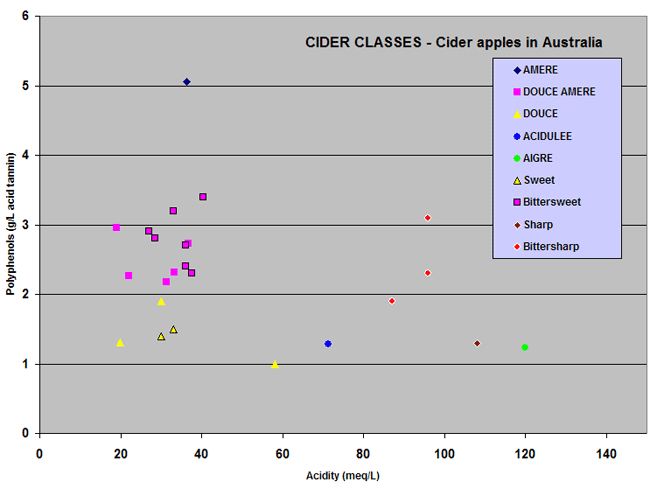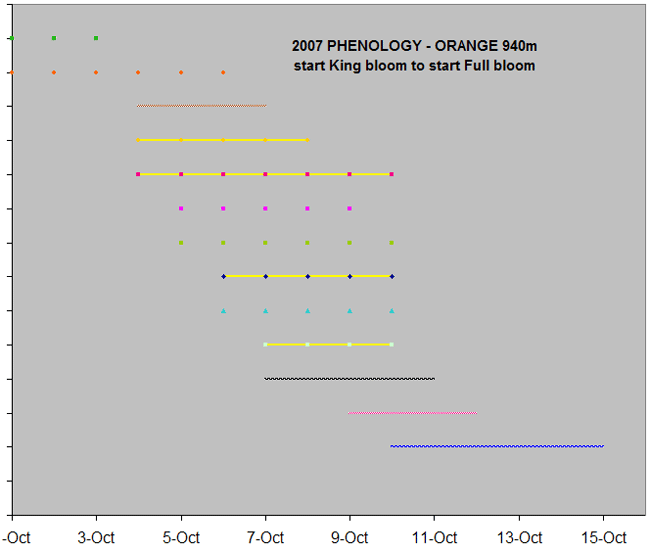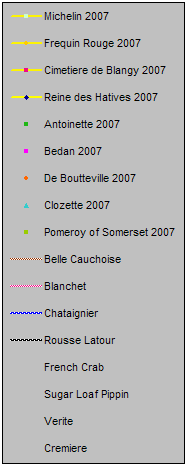
Additional cider varieties
The cider apple varieties covered elsewhere in these webpages have been grown under trial conditions and to a limited extent commercially and accordingly a reasonable amount of information about them has been accumulated.
Investigations have revealed that there are a number of other apple cider varieties that have been in Australia for some years but which have not been recognised as ciders.
In October 2007, David Pickering of NSW DPI undertook a study tour (with assistance from Horticulture Australia Ltd. – HAL) to obtain information about these varieties. The primary purpose of the study tour was to attempt to confirm that the identified apples were “true-to-type”, that is to confirm that Variety X in Australia is the same as Variety X in France and/or England.
The information obtained overseas has been compared with fruit of these varieties supplied by the Tasmanian DPI&W Grove Research Station.
As a result of this work it has been possible to confirm with a reasonable degree of certainty that additional varieties can be added to the list of cider apples available in Australia.
NB: There can be no absolute guarantee of the varieties being true-to-type without the conduct of DNA testing. Financial constraints prevent this being undertaken at present and prospective growers are therefore advised to take their own measures if they require unconditional proof.
There are yet more apple varieties that may be cider types. These are being investigated and will be added to the list when and if confirmed.
Variety naming
A number of the newly “re-discovered” cider varieties have for one reason or another had their names slightly misspelled or otherwise corrupted during importation or since.
The names used in the following list are the original names used in the country of origin. If there is an alternative name in common usage in Australia, then that name appears in brackets following the original.
This protocol has been decided for three reasons:
- So that Australian names conform to the country of origin.
- So that prospective growers can do their own research using the name in the country of origin.
- In case there are already growers of these apples under the name which has been used up until now.
Antoinette
Bedan (Bedon)
Belle Cauchoise (Belle Cacheuse)
Blanchet (Blanche)
Chataignier
Cimetiere de Blangy (Cimetiere du Pays)
Clozette (Closette)
Cremiere
De Boutteville (De Bouteville)
French Crab
* Frequin Rouge (Frequin Rouge Amer)
Pomeroy of Somerset (Taunton)
Rousse Latour (Rous Latour)
Sugar Loaf Pippin
Verite
* Frequin Rouge is a French cider variety but there are a various versions of it currently being used in France. We are not in a position to say which of the versions we have in Australia but it is reasonably safe to assume that Australia has only one version.
The English grouping of cider apple varieties into the traditional four categories of sweet, bittersweet, sharp and bittersharp has been in place for a long time. Classification varies slightly in France, where they have a six category system. The French categories are detailed below with the approximate translation:
| Variety | Category |
|---|---|
| AMERE | bitter |
| DOUCE AMERE | bitter-sweet |
| DOUCE | sweet |
| ACIDULEE | acid |
| AIGRE AMERE | bitter-sharp |
| AIGRE | sour, tart, sharp |
Both the English and the French system of categories are based on the acid and tannin content of the juice from the apples.
In order to compare the two systems - and see where particular varieties fit - a chart has been prepared. Please remember that the acid and tannin levels will be affected by locality, seasonal conditions, irrigation, tree age, etc etc and accordingly the levels are approximate only.
Little information is currently available as to the performance of these varieties under Australian conditions. What information is given in relation to these varieties is mostly taken from overseas sources and may well vary with our different climate and soils. Accordingly they should be used for guidance only.
Flowering
The main reference point is the flowering dates. The chart below details the 2007 dates of king and full bloom for a site near Orange NSW at about 940 metres elevation. It should be mentioned at the outset that 2007 was a very early flowering year.
In order to try and provide some guidance regarding flowering dates the chart incorporates two varieties that have been known for some time: Michelin and Reine des Hatives. These have been included as they provide a link between what information we have about Australian flowering dates and the flowering dates that are quoted in overseas (northern hemisphere) literature.
Overseas, flowering dates are often quoted in relation to commonly used varieties but unfortunately the commonly quoted varieties are not available in Australia. The four varieties with dots and connecting lines have a reasonable flowering history at Orange and generally retain their relative flowering positions.
The five varieties with un-connected dots flowered in 2007 with the dates shown, the main proviso in relation to the date is that they are young trees. The dates for the four varieties shown with stippled lines have been approximated from French literature using Michelin and Reine des Hatives as a reference point.
The final four varieties shown have not flowered in Orange and information cannot yet be obtained from overseas. All this flowering information will be reviewed and updated during the 2008 and 2009 flowering periods.

Phenology chart legend

Horticultural characteristics
A review of overseas published literature is currently being conducted in order to provide variety by variety information regarding vigour, disease reactions, bearing behaviour etc. This will be added to the website as overseas and local information becomes available.
Acknowledgements
Information within this article was made possible through a HAL subsidy of the study tour to England and France.
Collaboration is acknowledged with:
- Yves Lespinasse and Jean-Michel Bore of INRA at Angers, and Nathalie Dupont of CTPC at Sees - for assistance to the author both in France and subsequently.
- Mike Oakford of the Tasmanian Dept of Primary Industries & Water (Grove Research Station) for providing fruit to undertake variety confirmation.

